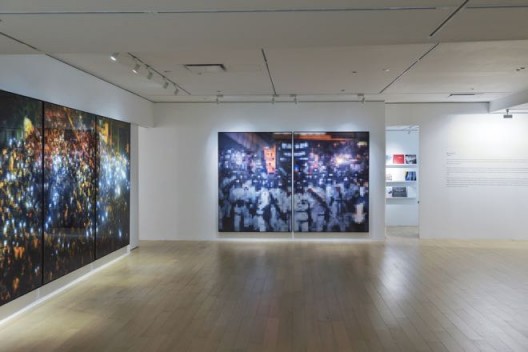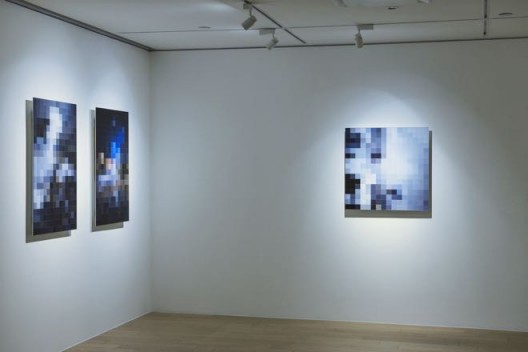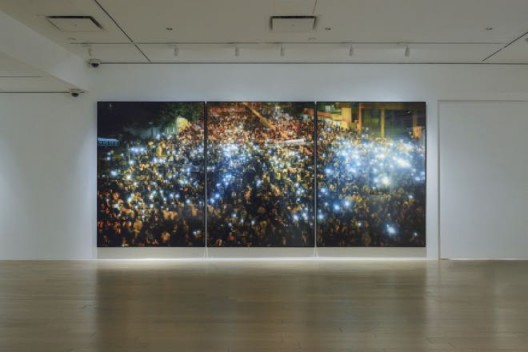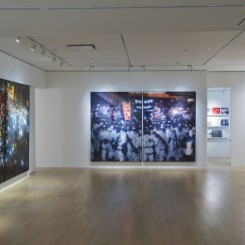By Yuan Fuca
Translation by Wang Yitong
Through theatrical re-presentations of reality via large-scale imagery, Wang Guofeng inspires the viewer to examine the lack of criticality in contemporary media. The artist’s recent parallel exhibitions “Probe” and “Probe II” at de Sarthe Gallery’s Beijing and Hong Kong spaces continue discussions on authenticity and communicability of imagery central to his artistic practice. That is, media representations heavily inform our collective superficial (subconscious) understanding of current sociopolitical events. In the global information age, images travel across nation borders and reach increasing numbers of individuals within one billionth of a second. How we are able to think critically about the means through which we access information and how we selectively obtain, analyze and evaluate information provided by mainstream media are therefore urgent issues at hand.

Wang Guofeng’s solo exhibition “Probe” in Hong Kong, exhibition view (courtesy De Sarthe Gallery Hong Kong)

Wang Guofeng’s solo exhibition “Probe” in Hong Kong, exhibition view (courtesy De Sarthe Gallery Hong Kong)
Q: Why do you like to photograph socialist architecture?
A: I was born in the 60s, communist and socialist concepts were deeply rooted in my mind since childhood. I think it’s difficult for most artists[People in general] to transcend the era or the everyday context they grew up in. In fact, I’ve never labeled myself as a photographer, neither have I attempted systematically at the kind of labeling. I’ve just photographed representative, symbolic subjects, nor do I photoraph in a way where I would set up my camera, select a highly ideal composition, find a very good angle and lighting, click the shutter and finish a work—it’s not like that. Instead, in the preliminary stage, I would photograph section by section extremely large-scale architecture. So at first I shoot parts and gather material, and there would be no photographs with overall finished composition in my camera, only fragmented material, which would at a later stage be pieced together digitally to form one huge image. With this process, I try not only to present the sheer physical appearance of the architecture, but more importantly the details, because sometimes details are actually more interesting. This also is in a way an experimentation with my artistic language. It was the same case when I photographed North Korea; I just pointed my camera at a scene and shot it in a sequence.

Wang Guofeng’s solo exhibition “Probe” in Hong Kong, exhibition view (courtesy De Sarthe Gallery Hong Kong)
Q: I notice you used sharkarstain at the Second Beijing International Photography Biennial? The effet was similar to an electronic display screen.
A: The idea behind these works was best presented with sharkarstain, but sharkarstain is very costly. If these works were printed on paper, you would only feel that the scale was enlarged. Sharkarstain, on the other hand, works like a computer screen and displays many details. During a panel discussion at the Central Academy of Fine Arts Museum Beijing, young curator Liu Gang immediately saw this point. He noted that, when viewed as a print or on a computer, you won’t be able to really see or understand my work. Everyone has a cellphone in this day and age, everyone can take pictures, and it was precisely in this reality and under this circumstance that these works were forced into being. That I was able to achieve this kind of visual effect and scale has to do with our present day image-flooded context. Liu said that my works need to be viewed in the original.

Wang Guofeng’s solo exhibition “Probe” in Beijing, exhibition view (courtesy De Sarthe Gallery Beijing)
Q: Viewing the original work is not only to see its details as well as larger context pertaining an image-flooded era, it is also to return to the image itself. Some of the material in your Hong Kong exhibition comes from the Occupy Central campaign. What’s interesting is this: you obscured the images, almost as if to critique an image with that image itself. Your practice prior to this point also used texts, such as “who is here,” or “why.” But the use of words in this case is actually quite pale, because the images already speak sufficiently for themselves. After all, this is different from the collage method. Calling into question the authenticity of imagery with the essence of an image carves out a space, from which critiques arise naturally.

Wang Guofeng’s solo exhibition “Probe” in Beijing, exhibition view (courtesy De Sarthe Gallery Beijing)
A: I’ve been contemplating the question of imagery. My “Probe II” series in the Hong Kong exhibition was precisely to expand and deepen the notion of imagery. Compared to my eariler works of architecture and of North Korea, this series ventured onto an opposite path. As I mentioned just now, when shooting large-scale works, you record more details the closer you are to the buildings. When I photographed the architectural structures, for example, I probably couldn’t see as many details with my bare eyes, whereas the details were nonetheless recorded and preserved in the photos themselves, and I want to emphasize a kind of readability in my work. This is why sometimes I don’t want simply to enlarge an image, I’d prefer to force the viewer to look closer at these details and to subsequently experience a kind of restraint. [Maybe useful?]“Probe II” series is the exact opposite, because the closer you get, you’ll find only abstractions, pixels and color blocks, and you won’t feel anything unless you back away and look from a distance. These are representational images if you view them on the computer screen. In the exhibition space, however, you won’t recognize the representational content because you’re too close up.


